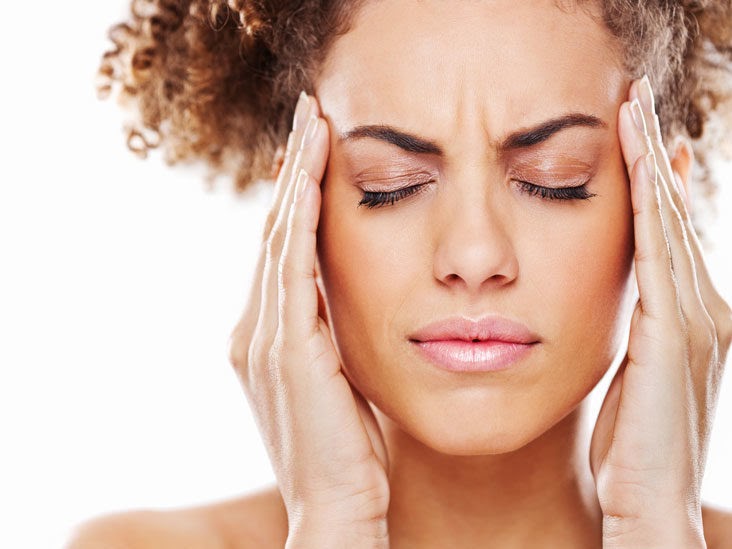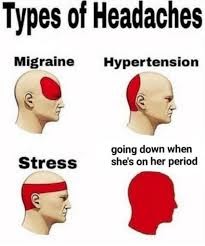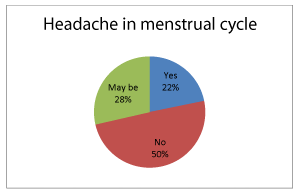The hormonal fluctuations during the menstrual cycle (Menstruation) cause many changes, and each person may experience different types of headaches throughout their cycle. These headaches can occur due to stress (such as a tight band around the forehead) or because of blood loss and iron deficiency after menstruation. Among the various types of headaches felt during menstruation, hormonal headaches and menstrual migraines (menstrual migraine) are the most common, with a similar underlying cause but different symptoms.
What are the causes of headaches during menstruation?
As hormones regulate many body functions, changes in hormone levels can lead to hormonal headaches and menstrual migraines. These headaches may appear before, during, or after the menstrual cycle. Headaches are caused by fluctuations in estrogen and progesterone levels. Estrogen (the female sex hormone) increases mid-cycle, leading to ovulation. Progesterone is another important hormone that helps the fertilized egg implant in the uterus.

After ovulation (the release of an egg from the ovary), hormone levels drop, and before menstruation, both estrogen and progesterone are at their lowest levels, which triggers headaches in women. Therefore, women may also experience hormonal headaches (Hormonal headache) during other times, such as menopause or after. During pregnancy, due to fluctuating hormone levels over the nine months, headaches may also occur.
Hormonal headache or menstrual migraine?
While both hormonal headaches and menstrual migraines are caused by hormonal fluctuations, the difference between the two is in the intensity of the headache.
Hormonal headaches are mild or moderate and cause pain or throbbing but do not interfere with the individual's daily activities. In contrast, menstrual migraines affect around 60% of women and can cause significant disruption. People who regularly experience migraines may be more sensitive to menstrual migraines.
Menstrual migraines are different from regular migraines and are usually not accompanied by an aura. In menstrual migraines, the pain is throbbing, typically starting from one side of the forehead and radiating to the other side, and it can be so intense that it prevents the person from opening their eyes, interfering with work or thinking.
Symptoms accompanying menstrual migraines
These symptoms include:
- Nausea
- Vomiting
- Sensitivity to sound
- Sensitivity to bright light

Common symptoms of menstruation that may be felt with both hormonal headaches and menstrual migraines are as follows:
- Extreme fatigue
- Joint or muscle pain
- Constipation or diarrhea
- Food cravings
- Mood changes
How to treat these headaches?
Treatment for hormonal headaches and menstrual migraines (menstrual migraine) depends on their severity. Pain relievers that are also useful for treating tension headaches and headaches caused by low iron levels can be effective for these headaches. Other medications for pain and inflammation include ibuprofen, sodium naproxen, aspirin, and acetaminophen.
Caffeine is another effective remedy for hormonal headaches, and consuming chocolate or drinking caffeinated tea or soda (read more here) is recommended to alleviate the pain. In fact, some medications prescribed for pain during menstruation contain caffeine. However, since caffeine is addictive, excessive consumption during menstruation can lead to physical dependence, and sudden cessation after menstruation may cause headaches again.
Depending on the severity of menstrual migraines, medication may not provide satisfactory results, and hormone therapy might be necessary. This treatment can help balance hormone levels before the menstrual cycle. Triptans are another class of drugs designed for the treatment of severe migraines. These medications reduce inflammation, constrict blood vessels, and help treat migraines by stimulating serotonin production.
Home remedies for headaches
- Cold therapy
Cold therapy reduces inflammation and pain. In this treatment, wrap an ice pack in a towel and place it on your forehead for 10 minutes, then remove it for 10 minutes, repeating the process.

- Relaxation exercises
Exercises such as meditation, yoga, and deep breathing can help relax muscles, reduce tension, and improve headache symptoms. Learning these exercises helps regulate body functions like heart rate and blood pressure, reduces muscle tension and stress, and consequently reduces the intensity of headaches.
- Adequate rest
Humans generally need at least seven to nine hours of sleep each night, and insufficient sleep can worsen headaches. For better rest, keep the room at a comfortable temperature and turn off the TV and lights.
- Vitamin consumption
Vitamins such as B-2, coenzyme Q10, and magnesium may reduce the severity of migraine attacks. However, it's recommended to consult your doctor before starting supplements, especially if you're pregnant or taking other medications.
- Massage therapy
Massage therapy helps loosen muscles and reduce tension in the shoulders, back, and neck. It can also decrease the intensity and frequency of tension headaches and migraine attacks.
- Acupuncture
Acupuncture (placing fine needles in specific points of the body) naturally promotes the release of endorphins and hormones that help reduce stress and pain.
When to see a doctor?
Any headache with the following symptoms, although not necessarily related to menstruation, requires serious attention and should be evaluated by a doctor:
- Confusion
- Seizures
- Double vision
- Numbness
- Difficulty speaking
If you experience frequent and severe headaches during your menstrual cycle, consult a doctor. The doctor may recommend hormone therapy or prescribe medications for treatment.












Our Customers' Comments
No comments registered